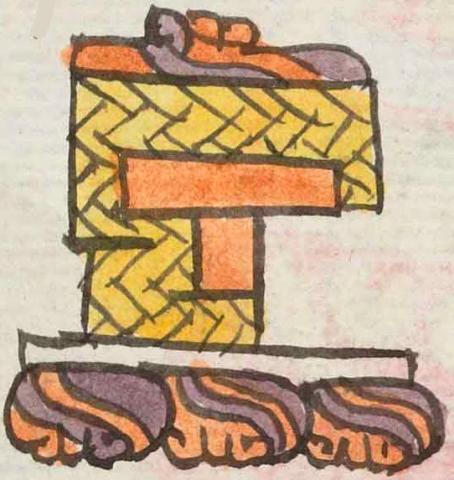Tepetlacalco (Mdz20r)
This compound glyph for the place name Tepetlacalco includes stones (tetl), handwoven reed mats (petlatl), and a building or house (calli). The building, with many right angles, is shown in profile, facing to the viewer's right. It has the classic T-shaped beam construction at the entrance, painted a terracotta color, and therefore likely wooden. The stones have the typical alternating purple and terracotta-colored, wavy lines and the curling elements around the edges, possibly representing rocky outcroppings. the locative suffix (-co) is not shown specifically, but the local landscape shown in the compound may serve as a semantic locative.
Stephanie Wood
tepetlacalco.puo
Tepetlacalco, pueblo
Stephanie Wood
c. 1541, or by 1553 at the latest
Stephanie Wood
The large stones at the bottom of the glyph could be the starting point (te-), although the stone at the top could also be a starting point. The petlatl component is in the middle, but it is also merged with the calli. So, merged is another possible reading.
rocks, stones, pietras, mats, petates, nombres de lugares

te(tl), stone or rock, https://nahuatl.wired-humanities.org/content/tetl
petla(tl), handwoven reed mat, https://nahuatl.wired-humanities.org/content/petlatl
petlacal(li), reed hamper, https://nahuatl.wired-humanities.org/content/petlacalli
-co (locative suffix), in or at, https://nahuatl.wired-humanities.org/content/co
Codex Mendoza, folio 20 recto, https://digital.bodleian.ox.ac.uk/objects/2fea788e-2aa2-4f08-b6d9-648c00..., image 50 of 188.
The Bodleian Libraries, University of Oxford, hold the original manuscript, the MS. Arch. Selden. A. 1. This image is published here under the UK Creative Commons, “Attribution-NonCommercial-ShareAlike 3.0 License” (CC-BY-NC-SA 3.0).

